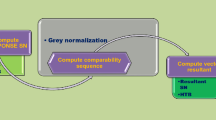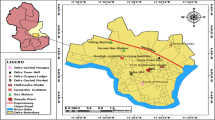Abstract
In the design and construction of pavement, properties of subgrade soil play a crucial role in maintaining the design life and preventing failures. If the subgrade has low strength or expansive properties, it will result in failure of the pavement and needs to be stabilized using different additives. In this study, cement, rice husk ash (RHA) and plastic waste are the additives being used to stabilize the soil. Besides, Taguchi analysis is used to optimize the additives. Unconfined Compressive Strength (UCS) and California Bearing Ratio (CBR) are the properties of soil evaluated using Taguchi L9 orthogonal array experiment design. Optimal values are found at 4% cement, 5% RHA and 0.5% plastic waste for CBR and 5% cement, 20% RHA and 1% plastic waste for UCS. At 5% cement, 5% RHA, and 0.5% plastic waste, Taguchi and Grey analysis results are shown to be optimal. Tests are conducted on the soil using final optimal combination to evaluate the CBR and UCS properties. The results indicate that the values obtained using Taguchi analysis approach are higher than those of conventional subgrade soil and all nine combinations obtained through Taguchi analysis. This reinforces the effectiveness of the Taguchi-based grey relational analysis in enhancing soil properties.






Similar content being viewed by others
References
Ackah FS, Hailiang W, Huai** F, Cheng L, Feng LZ (2022) Use of Taguchi method to evaluate the unconfined compressive strength of quicklime stabilized silty clayey subgrade. Case Stud Construction Mater 17:1–18. https://doi.org/10.1016/j.cscm.2022.e01417
Alighardashi A, Mehrani MJ, Fakhravar N et al (2018) Material design and characterization of pervious concrete reactive barrier containing nano-silica and fine pumice aggregate. Asian J Civ Eng 20:49–56. https://doi.org/10.1007/s42107-018-0087-3
Aswad Hassan HJ, Rasul J, Samin M (2021) Effects of plastic waste materials on geotechnical properties of clayey soil. Trans Infrastruct Geotechnol 8:390–413. https://doi.org/10.1007/s40515-020-00145-4
Mittal A, Shukla S, Verma S (2019) Stabilization of soil with waste plastic bottles. Proc Indian Geotech Conf 136:375–383. https://doi.org/10.1007/978-981-33-6444-8_34
Balamaheswari M, Anitha B, Kanimozhi B, Naganatha Prabhu L (2022) Improvement of California Bearing Ratio value in weak subgrade soil with the developed anchored geogrid. Mater Today 49(5):1537–1542. https://doi.org/10.1016/j.matpr.2021.07.311
Chen Y, Xu Y, Jamhiri B, Wang L, Li T (2022) Predicting uniaxial tensile strength of expansive soil with ensemble learning methods. Comput Geotech 150:104904. https://doi.org/10.1016/j.compgeo.2022.104904
Ewa DE, Enang A, Egbe JO, Ukpata AE (2023) Sustainable subgrade improvement using limestone dust and sugarcane bagasse ash. Sustain Technol Entrepreneurship 2(1):100028. https://doi.org/10.1016/j.stae.2022.100028
Barman D, Dash SK (2022) Stabilization of expansive soils using chemical additives: a review. J Rock Mech Geotech Eng 14(4):1319–1342. https://doi.org/10.1016/j.jrmge.2022.02.011
Eliaslankaran Z, Nik Daud NN, Md. Yusoff Z, Rostami V (2021) Evaluation of the effects of cement and lime with rice husk ash as an additive on strength behavior of coastal soil. Materials 14(5):1140, 1–15. https://doi.org/10.3390/ma14051140
Gangwar P, Tiwari S (2021) Stabilization of soil with waste plastic bottles. Mater Today 47(13):3802–3806. https://doi.org/10.1016/j.matpr.2021.03.010
Gireesh Kumar P, Harika S (2021) Stabilization of expansive subgrade soil by using fly ash. Mater Today 45(7):6558–6562. https://doi.org/10.1016/j.matpr.2020.11.469
Ikeagwuani CC, Agunwamba JC, Nwankwo CM, Eneh M (2021) Additives optimization for expansive soil subgrade modification based on Taguchi grey relational analysis. Int J Pavement Res Technol 14:138–152. https://orcid.org/0000-0001-5037-552X
Ikeagwuani CC, Nwonu DC (2021) Multi-additive optimization for expansive soil treatment using grey-super-efficiency model integrated in taguchi method. Indian Geotech J 51:1166–1181. https://doi.org/10.1007/s40098-021-00538-3
Ikeagwuani CC, Nwonu DC (2021) Variable returns to scale DEA—Taguchi approach for ternary additives optimization in expansive soil subgrade enhancement. Int J Geo-Eng 12:20. https://doi.org/10.1186/s40703-021-00149-0
IS: 2720 (Part 10)-1991 Methods of test for soils—Determination of Unconfined Compressive Strength, Bureau of Indian standards, New Delhi.
IS: 2720 (Part 16)-1987 Methods of test for soils—Laboratory determination of CBR, Bureau of Indian standards, New Delhi.
IS: 2720 (Part 7)-1980 Methods of test for soils—Determination of water content—dry density relation using light compaction, Bureau of Indian standards, New Delhi.
Jain A, Choudhary AK, Jha JN (2020) Influence of rice husk ash on the swelling and strength characteristics of expansive soil. Geotech Geol Eng 38:2293–2302. https://doi.org/10.1007/s10706-019-01087-6
Jalal FE, Jamhiri B, Naseem A, Hussain M, Iqbal M, Onyelowe K (2021) Isolated effect and sensitivity of agricultural and industrial waste Ca-based stabilizer materials (CSMs) in evaluating swell shrink Nature of Palygorskite-Rich Clays. Adv Civ Eng 2021.
Jamhiri B, Xu Y, Jalal FE (2022) Cracking propagation in expansive soils under desiccation and stabilization planning using Bayesian inference and Markov decision chains. Environ Sci Pollut Res 29(38):36740–36762. https://doi.org/10.1007/s11356-022-18690-5
Jiang X, Huang Z, Ma F, Luo X (2019) Analysis of strength development and soil–water characteristics of rice husk ash–lime stabilized soft soil. Materials 12(23):3873, 1–19. https://doi.org/10.3390/ma12233873
Celik K, Cagla Meral A, Petek Gursel P, Mehta K, Horvath A, Monteiro PJM (2015) Mechanical properties, durability, and life-cycle assessment of self-consolidating concrete mixtures made with blended portland cements containing fly ash and limestone powder. Cement Concr Compos 56:59–72. https://doi.org/10.1016/j.cemconcomp.2014.11.003
Kumar A, Sinha S, Saurav S et al (2023) Prediction of unconfined compressive strength of cement–fly ash stabilized soil using support vector machines. Asian J Civ Eng. https://doi.org/10.1007/s42107-023-00833-9
Lakshmi MS, Geetha S, Selvakumar M, Divya Susanna K (2021) Strength enhancement of Clayey Sand subgrade using lime and rice husk ash. Mater Today 46(17):7430–7435. https://doi.org/10.1016/j.matpr.2021.01.039
Olgun M (2013) The effects and optimization of additives for expansive clays under freeze–thaw conditions. Cold Reg Sci Technol 93:36–46. https://doi.org/10.1016/j.coldregions.2013.06.001
Nahar N, Owino AO, Khan SK, Hossain Z, Tamaki N (2021) Effects of controlled burn rice husk ash on the geotechnical properties of soil. J Agricult Eng 52(4):1216. https://doi.org/10.4081/jae.2021.1216
Onyelowe KC, Ebid AM, Hanandeh S et al (2023) The influence of fines on the hydro-mechanical behavior of sand for sustainable compacted liner and sub-base construction applications. Asian J Civ Eng. https://doi.org/10.1007/s42107-023-00800-4
Peddaiah S, Burman A, Sreedeep S (2018) Experimental study on effect of waste plastic bottle strips in soil improvement. Geotech Geol Eng 36(10):2907–2920. https://doi.org/10.1007/s10706-018-0512-0
Prasanna S (2019) Utilization of Waste Plastic Shreds for Stabilization of Soil. Geotech Trans Infrastruct Lecture Notes Civ Eng 29:619–628. https://doi.org/10.1007/978-981-13-6713-7_49
Praveen GV, Pandu Kurre, T. Chandrabai (2021) Improvement of California Bearing Ratio (CBR) value of Steel Fiber reinforced Cement modified Marginal Soil for pavement subgrade admixed with Fly Ash. Materials Today: Proceedings 39(1):639-642. https://doi.org/10.1016/j.matpr.2020.08.814
Reddy JJ, Varaprasad BJS, Venkateshwar Reddy P (2020) Application of Grey Taguchi Method to optimize the internal erosion parameters of stabilized soil. Multiscale and Multidisciplinary Modeling, Experiments and Design 4:99–108. https://doi.org/10.1007/s41939-020-00077-z
Vysakh P, Bindu J (2012) Stabilisation of lateritic soil using coconut shell, leaf and husk ash. In: 2012 International conference on green technologies (ICGT), Trivandrum, India, 274–279. https://doi.org/10.1109/ICGT.2012.6477985
Yadav AK, Gaurav K, Kishor R, Suman SK (2017) Stabilization of alluvial soil for subgrade using rice husk ash, sugarcane bagasse ash and cow dung ash for rural roads. Int J Pavement Res Technol 10(3):254–261. https://doi.org/10.1016/j.ijprt.2017.02.001
Acknowledgements
We extend our sincere appreciation to Ch. Srikanth, E. Princy, G.V.S.S. Prasad and K. Chinna babu for their efforts and commitment in conducting the experimental work. Their hard work, enthusiasm, and teamwork were crucial to the successful completion of this work.
Funding
This project was conducted without external funding.
Author information
Authors and Affiliations
Contributions
Dr. SSGP: Developed the methodology, performed the analysis, and prepared the initial draft of the report. Dr. KS: Conducted data analysis, contributed to writing the report, and provided editing support. Mr. ChM: Carried out experimental work for the study. All authors have thoroughly reviewed and approved the final manuscript.
Corresponding author
Ethics declarations
Conflict of interest
The authors declare no competing interests.
Additional information
Publisher's Note
Springer Nature remains neutral with regard to jurisdictional claims in published maps and institutional affiliations.
Rights and permissions
Springer Nature or its licensor (e.g. a society or other partner) holds exclusive rights to this article under a publishing agreement with the author(s) or other rightsholder(s); author self-archiving of the accepted manuscript version of this article is solely governed by the terms of such publishing agreement and applicable law.
About this article
Cite this article
Suvvari, S.G.P., Kandru, S. & Chappa, M. Optimization of cement, rice husk ash, and waste plastic additives for stabilizing expansive subgrade soil: a Grey-Taguchi analysis approach. J Build Rehabil 9, 8 (2024). https://doi.org/10.1007/s41024-023-00357-4
Received:
Revised:
Accepted:
Published:
DOI: https://doi.org/10.1007/s41024-023-00357-4




